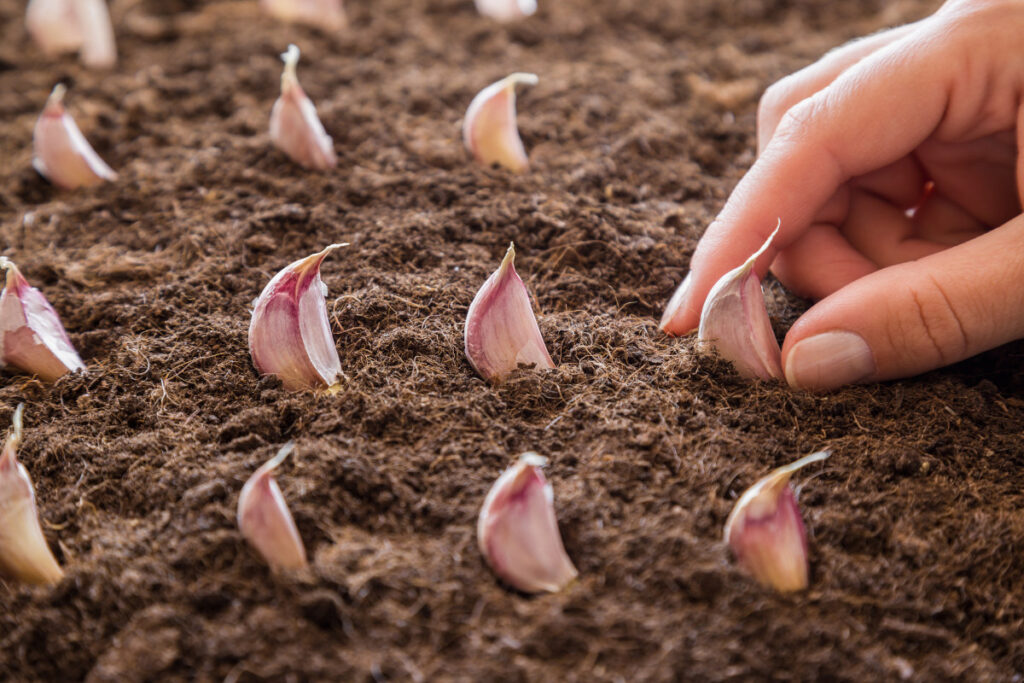If you grow your own garden, you’ve thought more than once about making garlic a part of it. One of the benefits of growing your own garlic is that it can be planted in the fall, giving it a head start for the next growing season. Whether you are a seasoned gardener or new to planting garlic, this article will provide you with all the information you need to successfully plant garlic in the fall.
Steps For Planting Garlic
We’re the first to admit we were a little overwhelmed the first time we planted garlic. And the next 10 times. But it began to fall into a routine that we’ve since gotten pretty used to. Unlike many plants, that you plant out in the spring with light frost, or even in the summer when all frost has passed, you need some good solid freezing to grow many varieties of garlic. And even the ones that don’t handle a freeze well need a good frost.
Use the following steps to get your garlic in the ground and a great crop in the early summer.
Choosing Your Garlic
Before planting garlic, it is important to choose the right type of garlic for your garden. There are two main types of garlic: softneck and hardneck. Softneck garlic is the type typically found in grocery stores and is known for its long storage life. It is a good choice for gardeners in mild climates, as it is not as hardy as hardneck garlic. Hardneck garlic, on the other hand, is known for its hard, woody stalk and more robust flavor. It is a better choice for gardeners in colder climates, as it is more tolerant of cold temperatures.
When choosing your garlic, look for bulbs that are large and healthy, with firm, tightly closed cloves. Avoid bulbs that are soft, shriveled, or have any signs of disease or damage.
Preparing Your Garden
Garlic is a hardy plant, but it still requires a well-prepared garden to thrive. Start by choosing a sunny spot in your garden that has well-draining soil. Garlic prefers soil that is slightly alkaline, with a pH between 6.0 and 7.0. If your soil is too acidic, you can amend it with lime to raise the pH.
Any big hardware store (think Lowes or Home Depot) will sell simple meters to test your soil pH. It sounds overwhelming, but it’s a very simple process with very detailed instructions.
Before planting, remove any weeds or debris from the garden bed and till the soil to a depth of about 12 inches. This will help to loosen the soil and allow the garlic roots to grow deeply. If your soil is compacted or heavy, you may want to add some compost or organic matter to improve the soil structure.
We plant standard mustard plants in our garlic fields for this very reason. Once it has bloomed, we can till under immediately for loosening the soil AND for killing harmful diseases or bugs that may harm the garlic.
Planting Your Garlic
Garlic is typically planted in the fall, about 6 to 8 weeks before the first hard frost in your area. This gives the garlic a head start on growth before winter sets in and allows the garlic to establish strong roots before the ground freezes.
To plant garlic, separate the bulbs into individual cloves, keeping the papery skin on each clove. Plant each clove with the pointy end facing up and the flat end facing down, about 2 inches deep and 4 to 6 inches apart. Cover the cloves with soil and water them in well.
After planting, mulch the garlic bed with a 2- to 3-inch layer of straw, leaves, or wood chips. This will help to conserve moisture in the soil and protect the garlic from freezing temperatures.
Caring for Your Garlic
Garlic is a low-maintenance crop that is easy to care for once it is planted. During the fall and winter, the garlic will go dormant and won’t require much attention. However, it is important to keep the soil evenly moist and to protect the garlic from extreme temperatures. Any form of winter precipitation will most likely accomplish this for you. Garden Garlic fields are not watered during the winter months.
In the spring, when the garlic begins to grow again, be sure to keep the bed free of weeds and mulched to conserve moisture. Garlic is not a heavy feeder, but it will benefit from a light application of compost or a balanced organic fertilizer every 4 to 6 weeks.
Harvesting Your Garlic
Garlic is typically ready to harvest in late spring or early summer, about 8 to 10 months after planting. To determine when your garlic is ready to harvest, look for the lower two or three stems to have turned brown and dried. Each stem can be associated with a layer of ‘paper’ around the garlic, so you don’t want to let them all die resulting in bare cloves.
You’ll find that the use of a spade or smaller digging tool will be very helpful in digging the garlic up. Some of the heads will resist being pulled if you attempt it by hand.
Lay them flat in a surface that allows air to get to the whole bulb, or tie them (braid softneck varieties) and hang in a well-ventilated room. Allow them to cure for several weeks until the bulbs have dried and hardened.
Depending on the variety you chose, bulbs can be stored for several months in a dark and cool place. Or try mincing and dehydrating for an amazing addition to your cooking.
Fall Planting
We gave you a bit of extra information here, aside from simply why you should plant your garlic in the fall. But it truly is a pretty simple process that needs very little oversite. With a little bit of cold through the winter, you’ll end up with beautifully formed bulbs in early summer.
